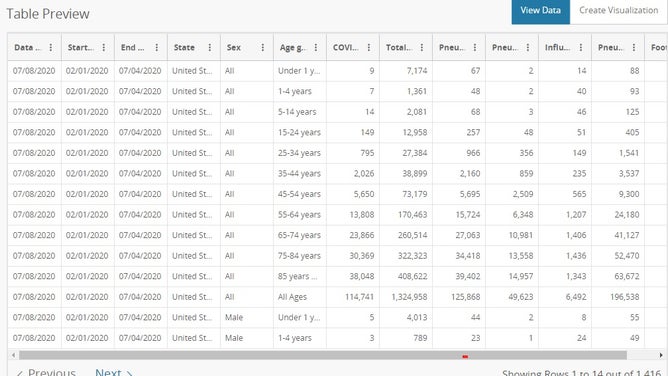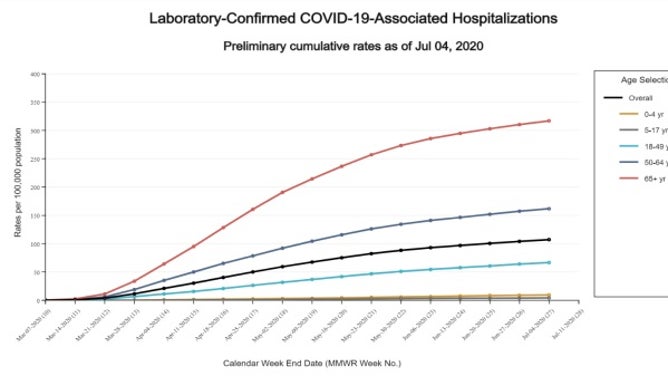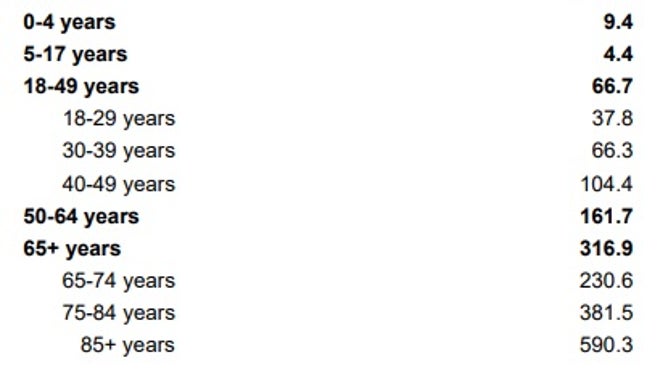The Case to Open Schools (and Sports)
This article was written by @OhioAtty14, who due to his legal job in the state of Ohio, has requested anonymity on this article.
There is a growing chorus of media opinion that it is too dangerous to open schools, and further, that fall sports just cannot happen. When confronted with the extremely low death rates of our youth, the thinking goes, "Well, you can't just look at that. You have to look at other factors."
So let's go through every relevant metric -- deaths, hospitalizations, transmissibility, side effects -- to see why schools should re-open and sports should be played.
Before even getting there, however, it is critically important that we understand basic age demographics in the United States. The most recent Census table is here.

As you can see, 82 million Americans (25.3% of the total population) are aged 0-24. Meanwhile, just 24 million Americans are age 75 and older (6.57% of the total population).
With that in mind, the first metric to look at is deaths. This is quite obviously not the only statistic to observe, but it is self-evidently the most important thing we are trying to avoid -- especially for kids who have their whole lives ahead of them. This data is available on the CDC Website

As you can see, through July 8, there have been just 179 deaths in people aged 0-24, while there have been 68,417 deaths in people aged 75+. Deaths also increase in every older age group. In other words, deaths directly correlate with age.
Standing alone, this is an absolutely remarkable statistic -- and it is why it is the first statistic cited when arguing to reopen schools. People aged 0-24 are 25.3% of the population yet account for just .15% of recorded deaths at CDC. People aged 75+ are just 6.57% of the population yet account for 60.1% of deaths.
In other words, for every 1,000 COVID deaths, people age 0-24 account for 1.5 deaths, and people age 75+ account for 601 deaths. That's...at least something to consider?
The next data point to analyze would be hospitalizations. The argument against opening would be, "Well, while young people may not die, perhaps they get sick, take up hospital beds, etc." After all, "flatten the curve" was originally about preserving hospital capacity, so this is an incredibly important metric for public health officials to consider. But again, young people aged 0-17 have incredibly low hospitalization rates from COVID. Per CDC's Weekly Summary ending July 4, hospitalization rates also directly correlate with age. The graph below shows that the hospitalization rates for people age 0-4 and age 5-17 are so low that they are barely even observable in the data compared to older populations.

And if that visual is not enough, look at the following table: people aged 65 and older are 72 times more likely to be hospitalized than people aged 5-17.

Thus, we can also conclude that the risk of kids being hospitalized is also incredibly low.
The next argument would involve the risk of infections to parents, teachers, and coaches. Here, the thinking goes, "We do not want to reopen schools and sports if they could become a breeding ground for the virus to spread elsewhere."
Yet, unfortunately, our essential workers were forced into a live experiment by putting their kids in daycares. This gives us a data point right here in the U.S. instead of Europe, where cases are admittedly lower.
Remarkably, this NPR article demonstrates that these daycares were not hotspots for kids, parents, or teachers. According to the article, the YMCA and New York City's Board of Education collectively cared for 50,000 kids at 1,270 sites -- so no small sample size. Per NPR: "The Y says a few staff members and parents at sites...did test positive, but there are no records of having more than one case at a site. This, among a population of essential workers."
Moreover, "In a separate, unscientific survey...Brown University economist Emily Oster found that...among 916 centers serving more than 20,000 children, just over 1% of staff and 0.16% of children were confirmed infected with the coronavirus."
This is consistent with findings for the many European countries, where schools also did not trigger hotspots. It is also worth noting that this live experiment was conducted in New York City -- the pandemic's worst epicenter (contrary to Governor Cuomo's revisionist history). And further, it was among the children of essential workers.
This live experiment, from which we have significant data and a huge sample size, should resolve public health officials' general fear that kids will get sick and transmit the virus to parents or teachers.
The next obstacle is the unknown long term side effects of COVID-19. The thinking here goes, "Well, we just don't know the long-term side effects of the virus, and we can't risk those unknowns moving forward."
Full disclosure -- I'm the dad of a 16-month old. The multi-immune system stories scared the fuck out of me.
Fortunately, and per the CDC, these terrible side effects are extremely rare and are mostly treatable.
To summarize, CDC observed just 186 cases in 26 states from March 15 to May 20. Four kids tragically died. Again, I'm a parent. I'd probably move to Mongolia and kill myself if my son died.
But 186 cases in 26 states over the course of 2+ months -- and 184 of 188 kids surviving -- means that these side-effects are ***extremely*** rare and mostly treatable.
Moreover, there are also long-term lung issues to consider. Again, however, significant side effects are rarely observed in kids. Per the University of Maryland:
"Unfortunately, we do not know if there are any long-term effects on lung function for children after infection with COVID-19 because this is a new strain of virus. The good news is that children do seem to have milder symptoms than adults. Often coronavirus symptoms are the same as the common cold, which usually does not leave lasting damage to the lungs."
As a parent, the word "unknown" there is admittedly scary; but we absolutely have to balance these not-yet-observed "unknowns" with the *known* consequences of school closures. Matt Yglesias, noted Vox writer and free speech enthusiast, eloquently explained them here:
1) Significant stress on parents trying to balance work/remote learning;
2) Kids academically falling behind;
3) Increased suicides, overdoses, and mental illness; and
4) Extremely negative consequences for the socioeconomically disadvantaged among us.
In summary, kids age 0-17 are extremely unlikely to die from COVID, be hospitalized with COVID, transmit COVID, or have side effects from COVID.
The fact that kids are spared is perhaps the only silver lining from a virus that has thus far caused over 130,000 deaths.
While I concede that I am not an epidemiologist or virologist, in my humble opinion, the evidence suggests that we should use this silver lining to our advantage. Our highest national priority should be reopening schools this fall -- as well as sports.
The significant benefits of school and extracurricular activities are voluminous and well documented. Schools provide learning, structure, routine, socialization, and here in the US, reopening will allow parents to have a semblance of their normal personal and professional life back.
Sports (and other extracurriculars) are no different. They provide physical health and teach teamwork, responsibility, and accountability. Study after study also shows that kids in extracurricular sports have better grades than kids that do not.
None of this is to say we should open the floodgates. School districts absolutely should take the appropriate precautions in their jurisdiction and follow the CDC guidelines as best as they are practicably and financially able.
Schools should also create individual plans for older teachers and coaches, as well as those that may be immuno-compromised, so that they are less susceptible to infection. Schools can also give parents the choice as to whether they'd prefer remote learning or in-person learning, and kids, of course, can absolutely choose whether they want to play sports or not.
But broad school closures -- and sports cancellations -- cannot continue. The known social, educational, economic, and mental health consequences are simply too dire to keep schools closed this fall.
So open the schools. Let the kids play. The data does not suggest it, it compels it.